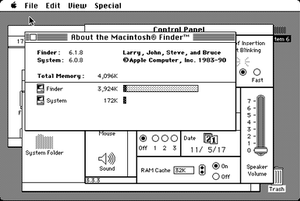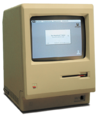
The history of the graphical user interface, understood as the use of graphic icons and a pointing device to control a computer, covers a five-decade span of incremental refinements, built on some constant core principles. Several vendors have created their own windowing systems based on independent code, but with basic elements in common that define the WIMP "window, icon, menu and pointing device" paradigm.
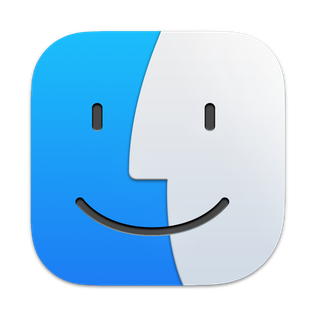
The Finder is the default file manager and graphical user interface shell used on all Macintosh operating systems. Described in its "About" window as "The Macintosh Desktop Experience", it is responsible for the launching of other applications, and for the overall user management of files, disks, and network volumes. It was introduced with the Macintosh 128K—the first Macintosh computer—and also exists as part of GS/OS on the Apple IIGS. It was rewritten completely with the release of Mac OS X in 2001.

MacPaint is a raster graphics editor developed by Apple Computer and released with the original Macintosh personal computer on January 24, 1984. It was sold separately for US$195 with its word processing counterpart, MacWrite. MacPaint was notable because it could generate graphics that could be used by other applications. It taught consumers what a graphics-based system could do by using the mouse, the clipboard, and QuickDraw picture language. Pictures could be cut from MacPaint and pasted into MacWrite documents.

A/UX is a Unix-based operating system from Apple Computer for Macintosh computers, integrated with System 7's graphical interface and application compatibility. It is Apple's first official Unix-based operating system, launched in 1988 and discontinued in 1995 with version 3.1.1. A/UX requires select 68k-based Macintosh models with an FPU and a paged memory management unit (PMMU), including the Macintosh II, SE/30, Quadra, and Centris series.
MacWrite is a discontinued WYSIWYG word processor released along with the first Apple Macintosh systems in 1984. Together with MacPaint, it was one of the two original "killer applications" that propelled the adoption and popularity of the GUI in general, and the Mac in particular.

System 7 is the seventh major release of the classic Mac OS operating system for Macintosh computers, made by Apple Computer. It was launched on May 13, 1991, to succeed System 6 with virtual memory, personal file sharing, QuickTime, TrueType fonts, the Force Quit dialog, and an improved user interface.
A desk accessory (DA) or desklet in computing is a small transient or auxiliary application that can be run concurrently in a desktop environment with any other application on the system. Early examples, such as Sidekick and Macintosh desk accessories, used special programming models to provide a small degree of multitasking on systems that initially did not have any other multitasking ability.
MultiFinder is an extension for the Apple Macintosh's classic Mac OS, introduced on August 11, 1987 and included with System Software 5. It adds cooperative multitasking of several applications at once – a great improvement over the previous Macintosh systems, which can only run one application at a time. With the advent of System 7, MultiFinder became a standard integrated part of the operating system and remained so until the introduction of Mac OS X.

Andrew Jay Hertzfeld is an American software engineer who was a member of Apple Computer's original Macintosh development team during the 1980s. After buying an Apple II in January 1978, he went to work for Apple Computer from August 1979 until March 1984, where he was a designer for the Macintosh system software.

Susan Kare is an American artist and graphic designer, who contributed interface elements and typefaces for the first Apple Macintosh personal computer from 1983 to 1986. She was employee #10 and creative director at NeXT, the company formed by Steve Jobs after he left Apple in 1985. She has worked as a design consultant to Microsoft, IBM, Sony Pictures, Facebook, and Pinterest. As of 2023 Kare has been an employee of Niantic Labs. As a pioneer of pixel art and of the graphical computer interface, she has been celebrated as one of the most significant designers of modern technology.

Mac OS 8 is the eighth major release of the classic Mac OS operating system for Macintosh computers, released by Apple Computer on July 26, 1997. It includes the largest overhaul of the classic Mac OS experience since the release of System 7, approximately six years before. It places a greater emphasis on color than prior versions. Released over a series of updates, Mac OS 8 represents an incremental integration of many of the technologies which had been developed from 1988 to 1996 for Apple's overly ambitious OS named Copland. Mac OS 8 helped modernize the Mac OS while Apple developed its next-generation operating system, Mac OS X.
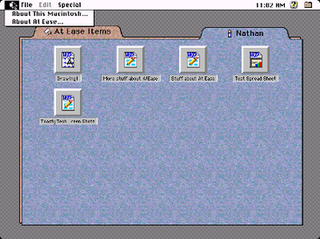
At Ease was an alternative to the Macintosh desktop developed by Apple Computer in the early 1990s for the classic Mac OS. It provided a simple environment for new Macintosh users and young children to help them to work without supervision. At Ease replaces the Finder desktop, providing a simple tabbed panel-oriented graphical user interface in which applications and documents are represented by icons on large buttons. Aside from its security features, its interface and basic functionality is very similar to the Packard Bell Navigator.

A menu bar is a graphical control element which contains drop-down menus.
The System suitcase is one of two essential files that make up the classic Mac OS, the other being the Macintosh Finder. If either file is missing or corrupted, a Macintosh may display a blinking question mark when booting. The suitcase is located in the System Folder, like the Finder file, and contains keyboard layouts, FKEY resources, cursors, icons, sounds, and, in System 6, bitmap fonts, and desk accessories. Mac OS only supports one System file; the presence of more than one System file on a hard disk is likely to cause system instability.
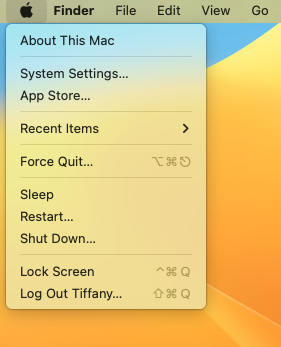
The Apple menu is a drop-down menu that is on the left side of the menu bar in the classic Mac OS, macOS and A/UX operating systems. The Apple menu's role has changed throughout the history of Apple Inc.'s operating systems, but the menu has always featured a version of the Apple logo.

In computing, the trash, also known by other names such as dustbin, wastebasket, and others, is a graphical user interface desktop metaphor for temporary storage for files set aside by the user for deletion, but not yet permanently erased. The concept and name is part of Mac operating systems, a similar implementation is called the Recycle Bin in Microsoft Windows, and other operating systems use other names.
Mac operating systems were developed by Apple Inc. in a succession of two major series.
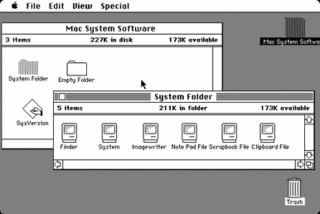
The Macintosh "System 1" is the first major release of the classic Mac OS operating system. It was developed for the Motorola 68000 microprocessor. System 1 was released on January 24, 1984, along with the Macintosh 128K, the first in the Macintosh family of personal computers. It received one update, "System 1.1" on December 29, 1984, before being succeeded by System 2.

Mac OS is the series of operating systems developed for the Macintosh family of personal computers by Apple Computer, Inc. from 1984 to 2001, starting with System 1 and ending with Mac OS 9. The Macintosh operating system is credited with having popularized the graphical user interface concept. It was included with every Macintosh that was sold during the era in which it was developed, and many updates to the system software were done in conjunction with the introduction of new Macintosh systems.
Comparison of user features of operating systems refers to a comparison of the general user features of major operating systems in a narrative format. It does not encompass a full exhaustive comparison or description of all technical details of all operating systems. It is a comparison of basic roles and the most prominent features. It also includes the most important features of the operating system's origins, historical development, and role.
